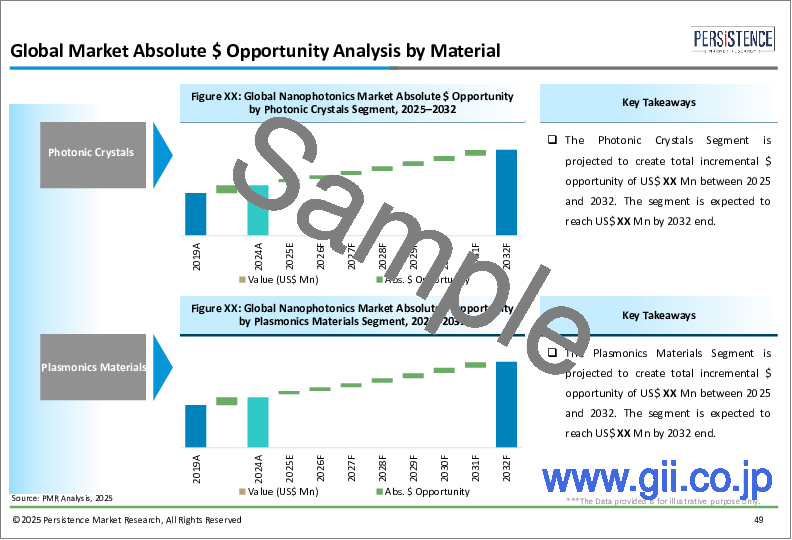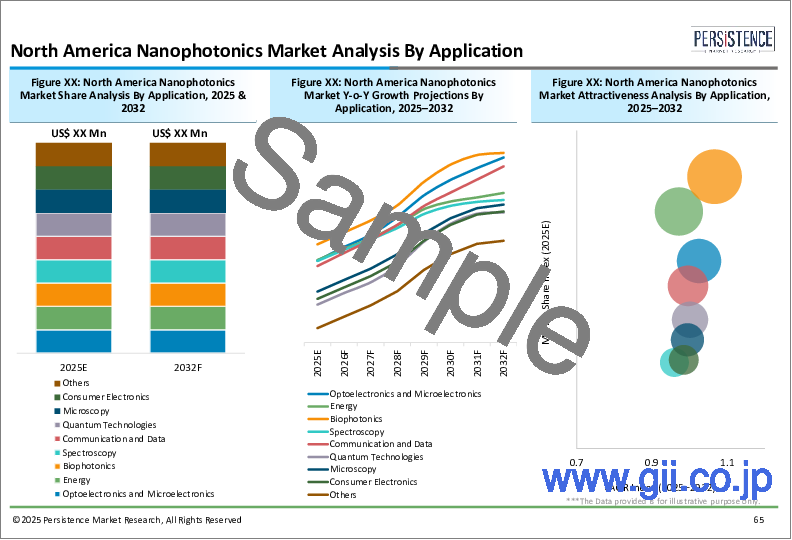|
|
市場調査レポート
商品コード
1537013
ナノフォトニクス市場:世界の産業分析、規模、シェア、成長、動向、2024-2031年予測Nanophotonics Market: Global Industry Analysis, Size, Share, Growth, Trends, and Forecast, 2024-2031 |
||||||
カスタマイズ可能
|
|||||||
| ナノフォトニクス市場:世界の産業分析、規模、シェア、成長、動向、2024-2031年予測 |
|
出版日: 2024年08月09日
発行: Persistence Market Research
ページ情報: 英文 250 Pages
納期: 2~5営業日
|
- 全表示
- 概要
- 目次
Persistence Market Research社はこのほど、世界のナノフォトニクス市場に関する包括的なレポートを発行しました。当レポートでは、市場促進要因・動向・機会・課題など、重要な市場力学を詳細に分析し、市場構造に関する詳細な洞察を提供しています。
主な洞察
- ナノフォトニクス市場規模(2024E):349億米ドル
- 市場予測額(2031F):2,194億米ドル
- 世界市場成長率(CAGR 2024-2031):22.7%
ナノフォトニクス市場- 調査範囲:
ナノフォトニクスは、光子とナノメートルスケールの材料との相互作用の研究であり、IT・通信、医療、エレクトロニクスなど様々な分野への応用で脚光を浴びています。この市場には、光通信、イメージングシステム、エネルギーハーベスティングなどの用途に使用されるナノフォトニクス材料とデバイスの開発と生産が含まれます。市場の成長は、ナノテクノロジーの進歩、高速データ伝送の需要増加、光学・フォトニックデバイスの技術革新によって推進されています。
市場促進要因:
世界のナノフォトニクス市場を牽引している主な要因はいくつかあります。高速・大容量データ伝送需要の高まりが、先進的フォトニックデバイスの必要性を煽っています。ナノ材料と製造技術の技術的進歩が、革新的なナノフォトニック・アプリケーションの開発を可能にしています。官民両部門による研究開発投資の拡大も市場成長に寄与しています。さらに、医療用イメージング、センサー、エネルギー効率の高い照明におけるナノフォトニクスの応用拡大が、市場拡大の新たな道を開いています。
市場抑制要因:
ナノフォトニクス市場は、その成長可能性にもかかわらず、高い開発コスト、複雑な製造プロセス、専門知識の必要性などの課題に直面しています。ナノフォトニクスデバイスの研究開発や製造にかかるコストが高いため、中小企業の市場参入が制限される可能性があります。さらに、ナノフォトニック技術は複雑なため、高度なインフラと厳格な品質管理対策が必要となり、これが普及の障壁となる可能性があります。
市場機会:
ナノフォトニクス市場は、新たなアプリケーションと技術の進歩によって大きな成長機会をもたらしています。ナノフォトニクス材料とデバイスの技術革新は、光通信、医療診断、環境センシングにブレークスルーをもたらす可能性があります。研究機関、技術開発者、業界関係者の協力により、イノベーションが促進され、ナノフォトニック技術の商業化が加速しています。量子コンピューティングや集積フォトニクスなどの新興分野での応用拡大も、市場成長の原動力になりそうです。
本レポートで扱う主な質問
- ナノフォトニクス市場の世界的成長を促進する主な要因は何か?
- ナノフォトニクス技術の採用を牽引しているアプリケーションは何か?
- ナノテクノロジーの進歩はナノフォトニクス市場の競合情勢にどのような影響を与えているか?
- ナノフォトニクス市場の主要プレーヤーは誰で、市場ポジションを維持するためにどのような戦略をとっているのか?
- 世界のナノフォトニクス市場における新たな動向と将来性は?
目次
第1章 エグゼクティブサマリー
第2章 市場概要
- 市場範囲/ 分類
- 市場の定義/ 範囲/ 制限
第3章 市場背景
- 市場力学
- シナリオ予測
- 機会マップ分析
- 投資実現可能性マトリックス
- PESTLEとポーター分析
- 規制状況
- 地域別親市場見通し
第4章 世界のナノフォトニクス市場分析
- 市場規模(金額)分析、2019~2023年
- 市場規模(金額)予測、2024~2031年
- 前年比成長動向分析
- 絶対的収益機会
第5章 製品別:世界のナノフォトニクス市場分析
- イントロダクション/主な調査結果
- 市場規模(金額)分析、2019~2023年
- 市場規模(金額)分析と予測、2024~2031年
- LED
- 有機EL
- 非営利
- 太陽電池
- 光増幅器
- 光スイッチ
- ホログラフィックデータストレージシステム
- 前年比成長動向分析、2019~2023年
- 絶対的収益機会、2024~2031年
第6章 原料別:世界のナノフォトニクス市場の分析
- イントロダクション/主な調査結果
- 市場規模(金額)分析、2019~2023年
- 市場規模(金額)分析と予測、2024~2031年
- フォトニック結晶
- プラズモニクスナノチューブ
- ナノリボン
- 量子ドット
- 前年比成長動向分析、2019~2023年
- 絶対的収益機会、2024~2031年
第7章 アプリケーション別:ナノフォトニクス市場分析
- イントロダクション/主な調査結果
- 市場規模(金額)分析、2019~2023年
- 市場規模(金額)分析と予測、2024~2031年
- 家電
- 材料科学
- 非可視波長計測機器
- 非視覚的アプリケーション
- 指標
- その他
- 前年比成長動向分析、2019~2023年
- 絶対的収益機会、2024~2031年
第8章 地域別:ナノフォトニクス市場分析
- イントロダクション
- 市場規模(金額)分析、2019~2023年
- 市場規模(金額)分析と予測、2024~2031年
- 北米
- ラテンアメリカ
- 欧州
- アジア太平洋
- 中東・アフリカ
- 地域別市場の魅力分析
第9章 北米フォトニクス市場分析(国別)
第10章 ラテンアメリカのナノフォトニクス市場分析(国別)
第11章 欧州のナノフォトニクス市場分析(国別)
第12章 アジア太平洋地域のナノフォトニクス市場分析(国別)
第13章 中東およびアフリカのナノフォトニクス市場分析(国別)
第14章 主要国のナノフォトニクス市場分析
- 米国
- カナダ
- ブラジル
- メキシコ
- ドイツ
- 英国
- フランス
- スペイン
- イタリア
- 中国
- 日本
- 韓国
- シンガポール
- タイ
- インドネシア
- オーストラリア
- ニュージーランド
- GCC諸国
- 南アフリカ
- イスラエル
第15章 市場構造分析
- 競合ダッシュボード
- 競合ベンチマーク
- 主要企業の市場シェア分析
第16章 競合分析
- 競合の詳細
- IBM
- Samsung SDI
- Viavi Solutions Lumentum Holdings
- BuckyUSA
- Carbon Solutions
- Cambrios Technologies
- Cnano Technology
- Wolfspeed
- LG Display
- Nanocs
第17章 使用される前提条件と頭字語
第18章 調査手法
Persistence Market Research has recently published a comprehensive report on the global Nanophotonics Market. This report provides an in-depth analysis of critical market dynamics, including drivers, trends, opportunities, and challenges, offering detailed insights into the market structure.
Key Insights:
- Nanophotonics Market Size (2024E): USD 34.9 Bn
- Projected Market Value (2031F): USD 219.4 Bn
- Global Market Growth Rate (CAGR 2024-2031): 22.7%
Nanophotonics Market - Report Scope:
Nanophotonics, the study of the interaction between photons and nanometer-scale materials, is gaining prominence for its applications across various fields such as telecommunications, medicine, and electronics. This market encompasses the development and production of nanophotonic materials and devices used in applications including optical communications, imaging systems, and energy harvesting. The market's growth is propelled by advancements in nanotechnology, increasing demand for high-speed data transmission, and innovations in optical and photonic devices.
Market Growth Drivers:
Several key factors are driving the global nanophotonics market. The rise in demand for high-speed and high-capacity data transmission fuels the need for advanced photonic devices. Technological advancements in nanomaterials and fabrication techniques are enabling the development of innovative nanophotonic applications. Growing investments in research and development by both public and private sectors are also contributing to market growth. Additionally, increasing applications of nanophotonics in medical imaging, sensors, and energy-efficient lighting are opening new avenues for market expansion.
Market Restraints:
Despite its growth potential, the nanophotonics market faces challenges such as high development costs, complex manufacturing processes, and the need for specialized expertise. The high costs associated with R&D and production of nanophotonic devices can limit market entry for smaller players. Additionally, the intricate nature of nanophotonic technology requires advanced infrastructure and stringent quality control measures, which can be a barrier to widespread adoption.
Market Opportunities:
The nanophotonics market presents significant growth opportunities driven by emerging applications and technological advancements. Innovations in nanophotonic materials and devices offer potential breakthroughs in optical communication, medical diagnostics, and environmental sensing. Collaborative efforts between research institutions, technology developers, and industry players are fostering innovation and accelerating the commercialization of nanophotonic technologies. Expanding applications in emerging sectors such as quantum computing and integrated photonics are also likely to drive market growth.
Key Questions Answered in the Report:
- What are the primary factors driving the growth of the nanophotonics market globally?
- Which applications are leading the adoption of nanophotonic technologies?
- How are advancements in nanotechnology influencing the competitive landscape of the nanophotonics market?
- Who are the key players in the nanophotonics market, and what strategies are they employing to maintain their market position?
- What are the emerging trends and future prospects in the global nanophotonics market?
Competitive Intelligence and Business Strategy:
Leading players in the global nanophotonics market, such as Nanosys, Optics11, and Cnano Technology, focus on innovation, strategic partnerships, and technological advancements to gain a competitive edge. These companies invest heavily in R&D to develop cutting-edge nanophotonic solutions and expand their product portfolios. Collaborations with research institutions and technology providers enhance market access and support the commercialization of new technologies. Additionally, navigating complex manufacturing challenges and addressing market needs through tailored solutions strengthens their market positioning.
Key Companies Profiled:
- IBM
- Samsung SDI
- Viavi Solutions Lumentum Holdings
- BuckyUSA
- Carbon Solutions
- Cambrios Technologies
- Cnano Technology
- Wolfspeed
- LG Display
- Nanocs
Global Nanophotonics Market Segmentation:
By Product:
- LED
- OLED
- NFO
- Photovoltaic Cells
- Optical Amplifier
- Optical Switches
- Holographic Data Storage System
By Ingredients:
- Photonic Crystals
- Plasmonics Nanotubes
- Nanoribbons
- Quantum Dots
By Application:
- Consumer Electronics
- Material Science
- Nonvisible Wavelength Instruments
- Nonvisual Applications
- Indicators
By Region:
- North America
- Latin America
- Europe
- Asia Pacific
- Middle East and Africa
Table of Contents
1. Executive Summary
- 1.1. Global Market Outlook
- 1.2. Demand-side Trends
- 1.3. Supply-side Trends
- 1.4. Technology Roadmap Analysis
- 1.5. Analysis and Recommendations
2. Market Overview
- 2.1. Market Coverage / Taxonomy
- 2.2. Market Definition / Scope / Limitations
3. Market Background
- 3.1. Market Dynamics
- 3.1.1. Drivers
- 3.1.2. Restraints
- 3.1.3. Opportunity
- 3.1.4. Trends
- 3.2. Scenario Forecast
- 3.2.1. Demand in Optimistic Scenario
- 3.2.2. Demand in Likely Scenario
- 3.2.3. Demand in Conservative Scenario
- 3.3. Opportunity Map Analysis
- 3.4. Investment Feasibility Matrix
- 3.5. PESTLE and Porter's Analysis
- 3.6. Regulatory Landscape
- 3.6.1. By Key Regions
- 3.6.2. By Key Countries
- 3.7. Regional Parent Market Outlook
4. Global Nanophotonics Market Analysis 2019-2023 and Forecast, 2024-2031
- 4.1. Historical Market Size Value (US$ Bn) Analysis, 2019-2023
- 4.2. Current and Future Market Size Value (US$ Bn) Projections, 2024-2031
- 4.2.1. Y-o-Y Growth Trend Analysis
- 4.2.2. Absolute $ Opportunity Analysis
5. Global Nanophotonics Market Analysis 2019-2023 and Forecast 2024-2031, By Product
- 5.1. Introduction / Key Findings
- 5.2. Historical Market Size Value (US$ Bn) Analysis By Product, 2019-2023
- 5.3. Current and Future Market Size Value (US$ Bn) Analysis and Forecast By Product, 2024-2031
- 5.3.1. LED
- 5.3.2. OLED
- 5.3.3. NFO
- 5.3.4. Photovoltaic Cells
- 5.3.5. Optical Amplifier
- 5.3.6. Optical Switches
- 5.3.7. Holographic Data Storage System
- 5.4. Y-o-Y Growth Trend Analysis By Product, 2019-2023
- 5.5. Absolute $ Opportunity Analysis By Product, 2024-2031
6. Global Nanophotonics Market Analysis 2019-2023 and Forecast 2024-2031, By Ingredients
- 6.1. Introduction / Key Findings
- 6.2. Historical Market Size Value (US$ Bn) Analysis By Ingredients, 2019-2023
- 6.3. Current and Future Market Size Value (US$ Bn) Analysis and Forecast By Ingredients, 2024-2031
- 6.3.1. Photonic Crystals
- 6.3.2. Plasmonics Nanotubes
- 6.3.3. Nanoribbons
- 6.3.4. Quantum Dots
- 6.4. Y-o-Y Growth Trend Analysis By Ingredients, 2019-2023
- 6.5. Absolute $ Opportunity Analysis By Ingredients, 2024-2031
7. Global Nanophotonics Market Analysis 2019-2023 and Forecast 2024-2031, By Application
- 7.1. Introduction / Key Findings
- 7.2. Historical Market Size Value (US$ Bn) Analysis By Application, 2019-2023
- 7.3. Current and Future Market Size Value (US$ Bn) Analysis and Forecast By Application, 2024-2031
- 7.3.1. Consumer Electronics
- 7.3.2. Material Science
- 7.3.3. Nonvisible Wavelength Instruments
- 7.3.4. Nonvisual Applications
- 7.3.5. Indicators
- 7.3.6. Others
- 7.4. Y-o-Y Growth Trend Analysis By Application, 2019-2023
- 7.5. Absolute $ Opportunity Analysis By Application, 2024-2031
8. Global Nanophotonics Market Analysis 2019-2023 and Forecast 2024-2031, By Region
- 8.1. Introduction
- 8.2. Historical Market Size Value (US$ Bn) Analysis By Region, 2019-2023
- 8.3. Current Market Size Value (US$ Bn) Analysis and Forecast By Region, 2024-2031
- 8.3.1. North America
- 8.3.2. Latin America
- 8.3.3. Europe
- 8.3.4. Asia Pacific
- 8.3.5. Middle East & Africa
- 8.4. Market Attractiveness Analysis By Region
9. North America Nanophotonics Market Analysis 2019-2023 and Forecast 2024-2031, By Country
- 9.1. Historical Market Size Value (US$ Bn) Trend Analysis By Market Taxonomy, 2019-2023
- 9.2. Market Size Value (US$ Bn) Forecast By Market Taxonomy, 2024-2031
- 9.2.1. By Country
- 9.2.1.1. United States
- 9.2.1.2. Canada
- 9.2.2. By Product
- 9.2.3. By Ingredients
- 9.2.4. By Application
- 9.2.1. By Country
- 9.3. Market Attractiveness Analysis
- 9.3.1. By Country
- 9.3.2. By Product
- 9.3.3. By Ingredients
- 9.3.4. By Application
- 9.4. Key Takeaways
10. Latin America Nanophotonics Market Analysis 2019-2023 and Forecast 2024-2031, By Country
- 10.1. Historical Market Size Value (US$ Bn) Trend Analysis By Market Taxonomy, 2019-2023
- 10.2. Market Size Value (US$ Bn) Forecast By Market Taxonomy, 2024-2031
- 10.2.1. By Country
- 10.2.1.1. Brazil
- 10.2.1.2. Mexico
- 10.2.1.3. Rest of Latin America
- 10.2.2. By Product
- 10.2.3. By Ingredients
- 10.2.4. By Application
- 10.2.1. By Country
- 10.3. Market Attractiveness Analysis
- 10.3.1. By Country
- 10.3.2. By Product
- 10.3.3. By Ingredients
- 10.3.4. By Application
- 10.4. Key Takeaways
11. Europe Nanophotonics Market Analysis 2019-2023 and Forecast 2024-2031, By Country
- 11.1. Historical Market Size Value (US$ Bn) Trend Analysis By Market Taxonomy, 2019-2023
- 11.2. Market Size Value (US$ Bn) Forecast By Market Taxonomy, 2024-2031
- 11.2.1. By Country
- 11.2.1.1. Germany
- 11.2.1.2. United Kingdom
- 11.2.1.3. France
- 11.2.1.4. Spain
- 11.2.1.5. Italy
- 11.2.1.6. Rest of Europe
- 11.2.2. By Product
- 11.2.3. By Ingredients
- 11.2.4. By Application
- 11.2.1. By Country
- 11.3. Market Attractiveness Analysis
- 11.3.1. By Country
- 11.3.2. By Product
- 11.3.3. By Ingredients
- 11.3.4. By Application
- 11.4. Key Takeaways
12. Asia Pacific Nanophotonics Market Analysis 2019-2023 and Forecast 2024-2031, By Country
- 12.1. Historical Market Size Value (US$ Bn) Trend Analysis By Market Taxonomy, 2019-2023
- 12.2. Market Size Value (US$ Bn) Forecast By Market Taxonomy, 2024-2031
- 12.2.1. By Country
- 12.2.1.1. China
- 12.2.1.2. Japan
- 12.2.1.3. South Korea
- 12.2.1.4. Singapore
- 12.2.1.5. Thailand
- 12.2.1.6. Indonesia
- 12.2.1.7. Australia
- 12.2.1.8. New Zealand
- 12.2.1.9. Rest of Asia Pacific
- 12.2.2. By Product
- 12.2.3. By Ingredients
- 12.2.4. By Application
- 12.2.1. By Country
- 12.3. Market Attractiveness Analysis
- 12.3.1. By Country
- 12.3.2. By Product
- 12.3.3. By Ingredients
- 12.3.4. By Application
- 12.4. Key Takeaways
13. Middle East & Africa Nanophotonics Market Analysis 2019-2023 and Forecast 2024-2031, By Country
- 13.1. Historical Market Size Value (US$ Bn) Trend Analysis By Market Taxonomy, 2019-2023
- 13.2. Market Size Value (US$ Bn) Forecast By Market Taxonomy, 2024-2031
- 13.2.1. By Country
- 13.2.1.1. GCC Countries
- 13.2.1.2. South Africa
- 13.2.1.3. Israel
- 13.2.1.4. Rest of Middle East & Africa
- 13.2.2. By Product
- 13.2.3. By Ingredients
- 13.2.4. By Application
- 13.2.1. By Country
- 13.3. Market Attractiveness Analysis
- 13.3.1. By Country
- 13.3.2. By Product
- 13.3.3. By Ingredients
- 13.3.4. By Application
- 13.4. Key Takeaways
14. Key Countries Nanophotonics Market Analysis
- 14.1. United States
- 14.1.1. Pricing Analysis
- 14.1.2. Market Share Analysis, 2024
- 14.1.2.1. By Product
- 14.1.2.2. By Ingredients
- 14.1.2.3. By Application
- 14.2. Canada
- 14.2.1. Pricing Analysis
- 14.2.2. Market Share Analysis, 2024
- 14.2.2.1. By Product
- 14.2.2.2. By Ingredients
- 14.2.2.3. By Application
- 14.3. Brazil
- 14.3.1. Pricing Analysis
- 14.3.2. Market Share Analysis, 2024
- 14.3.2.1. By Product
- 14.3.2.2. By Ingredients
- 14.3.2.3. By Application
- 14.4. Mexico
- 14.4.1. Pricing Analysis
- 14.4.2. Market Share Analysis, 2024
- 14.4.2.1. By Product
- 14.4.2.2. By Ingredients
- 14.4.2.3. By Application
- 14.5. Germany
- 14.5.1. Pricing Analysis
- 14.5.2. Market Share Analysis, 2024
- 14.5.2.1. By Product
- 14.5.2.2. By Ingredients
- 14.5.2.3. By Application
- 14.6. United Kingdom
- 14.6.1. Pricing Analysis
- 14.6.2. Market Share Analysis, 2024
- 14.6.2.1. By Product
- 14.6.2.2. By Ingredients
- 14.6.2.3. By Application
- 14.7. France
- 14.7.1. Pricing Analysis
- 14.7.2. Market Share Analysis, 2024
- 14.7.2.1. By Product
- 14.7.2.2. By Ingredients
- 14.7.2.3. By Application
- 14.8. Spain
- 14.8.1. Pricing Analysis
- 14.8.2. Market Share Analysis, 2024
- 14.8.2.1. By Product
- 14.8.2.2. By Ingredients
- 14.8.2.3. By Application
- 14.9. Italy
- 14.9.1. Pricing Analysis
- 14.9.2. Market Share Analysis, 2024
- 14.9.2.1. By Product
- 14.9.2.2. By Ingredients
- 14.9.2.3. By Application
- 14.10. China
- 14.10.1. Pricing Analysis
- 14.10.2. Market Share Analysis, 2024
- 14.10.2.1. By Product
- 14.10.2.2. By Ingredients
- 14.10.2.3. By Application
- 14.11. Japan
- 14.11.1. Pricing Analysis
- 14.11.2. Market Share Analysis, 2024
- 14.11.2.1. By Product
- 14.11.2.2. By Ingredients
- 14.11.2.3. By Application
- 14.12. South Korea
- 14.12.1. Pricing Analysis
- 14.12.2. Market Share Analysis, 2024
- 14.12.2.1. By Product
- 14.12.2.2. By Ingredients
- 14.12.2.3. By Application
- 14.13. Singapore
- 14.13.1. Pricing Analysis
- 14.13.2. Market Share Analysis, 2024
- 14.13.2.1. By Product
- 14.13.2.2. By Ingredients
- 14.13.2.3. By Application
- 14.14. Thailand
- 14.14.1. Pricing Analysis
- 14.14.2. Market Share Analysis, 2024
- 14.14.2.1. By Product
- 14.14.2.2. By Ingredients
- 14.14.2.3. By Application
- 14.15. Indonesia
- 14.15.1. Pricing Analysis
- 14.15.2. Market Share Analysis, 2024
- 14.15.2.1. By Product
- 14.15.2.2. By Ingredients
- 14.15.2.3. By Application
- 14.16. Australia
- 14.16.1. Pricing Analysis
- 14.16.2. Market Share Analysis, 2024
- 14.16.2.1. By Product
- 14.16.2.2. By Ingredients
- 14.16.2.3. By Application
- 14.17. New Zealand
- 14.17.1. Pricing Analysis
- 14.17.2. Market Share Analysis, 2024
- 14.17.2.1. By Product
- 14.17.2.2. By Ingredients
- 14.17.2.3. By Application
- 14.18. GCC Countries
- 14.18.1. Pricing Analysis
- 14.18.2. Market Share Analysis, 2024
- 14.18.2.1. By Product
- 14.18.2.2. By Ingredients
- 14.18.2.3. By Application
- 14.19. South Africa
- 14.19.1. Pricing Analysis
- 14.19.2. Market Share Analysis, 2024
- 14.19.2.1. By Product
- 14.19.2.2. By Ingredients
- 14.19.2.3. By Application
- 14.20. Israel
- 14.20.1. Pricing Analysis
- 14.20.2. Market Share Analysis, 2024
- 14.20.2.1. By Product
- 14.20.2.2. By Ingredients
- 14.20.2.3. By Application
15. Market Structure Analysis
- 15.1. Competition Dashboard
- 15.2. Competition Benchmarking
- 15.3. Market Share Analysis of Top Players
- 15.3.1. By Regional
- 15.3.2. By Product
- 15.3.3. By Ingredients
- 15.3.4. By Application
16. Competition Analysis
- 16.1. Competition Deep Dive
- 16.1.1. IBM
- 16.1.1.1. Overview
- 16.1.1.2. Product Portfolio
- 16.1.1.3. Profitability by Market Segments
- 16.1.1.4. Sales Footprint
- 16.1.1.5. Strategy Overview
- 16.1.1.5.1. Marketing Strategy
- 16.1.2. Samsung SDI
- 16.1.2.1. Overview
- 16.1.2.2. Product Portfolio
- 16.1.2.3. Profitability by Market Segments
- 16.1.2.4. Sales Footprint
- 16.1.2.5. Strategy Overview
- 16.1.2.5.1. Marketing Strategy
- 16.1.3. Viavi Solutions Lumentum Holdings
- 16.1.3.1. Overview
- 16.1.3.2. Product Portfolio
- 16.1.3.3. Profitability by Market Segments
- 16.1.3.4. Sales Footprint
- 16.1.3.5. Strategy Overview
- 16.1.3.5.1. Marketing Strategy
- 16.1.4. BuckyUSA
- 16.1.4.1. Overview
- 16.1.4.2. Product Portfolio
- 16.1.4.3. Profitability by Market Segments
- 16.1.4.4. Sales Footprint
- 16.1.4.5. Strategy Overview
- 16.1.4.5.1. Marketing Strategy
- 16.1.5. Carbon Solutions
- 16.1.5.1. Overview
- 16.1.5.2. Product Portfolio
- 16.1.5.3. Profitability by Market Segments
- 16.1.5.4. Sales Footprint
- 16.1.5.5. Strategy Overview
- 16.1.5.5.1. Marketing Strategy
- 16.1.6. Cambrios Technologies
- 16.1.6.1. Overview
- 16.1.6.2. Product Portfolio
- 16.1.6.3. Profitability by Market Segments
- 16.1.6.4. Sales Footprint
- 16.1.6.5. Strategy Overview
- 16.1.6.5.1. Marketing Strategy
- 16.1.7. Cnano Technology
- 16.1.7.1. Overview
- 16.1.7.2. Product Portfolio
- 16.1.7.3. Profitability by Market Segments
- 16.1.7.4. Sales Footprint
- 16.1.7.5. Strategy Overview
- 16.1.7.5.1. Marketing Strategy
- 16.1.8. Wolfspeed
- 16.1.8.1. Overview
- 16.1.8.2. Product Portfolio
- 16.1.8.3. Profitability by Market Segments
- 16.1.8.4. Sales Footprint
- 16.1.8.5. Strategy Overview
- 16.1.8.5.1. Marketing Strategy
- 16.1.9. LG Display
- 16.1.9.1. Overview
- 16.1.9.2. Product Portfolio
- 16.1.9.3. Profitability by Market Segments
- 16.1.9.4. Sales Footprint
- 16.1.9.5. Strategy Overview
- 16.1.9.5.1. Marketing Strategy
- 16.1.10. Nanocs
- 16.1.10.1. Overview
- 16.1.10.2. Product Portfolio
- 16.1.10.3. Profitability by Market Segments
- 16.1.10.4. Sales Footprint
- 16.1.10.5. Strategy Overview
- 16.1.10.5.1. Marketing Strategy
- 16.1.1. IBM






